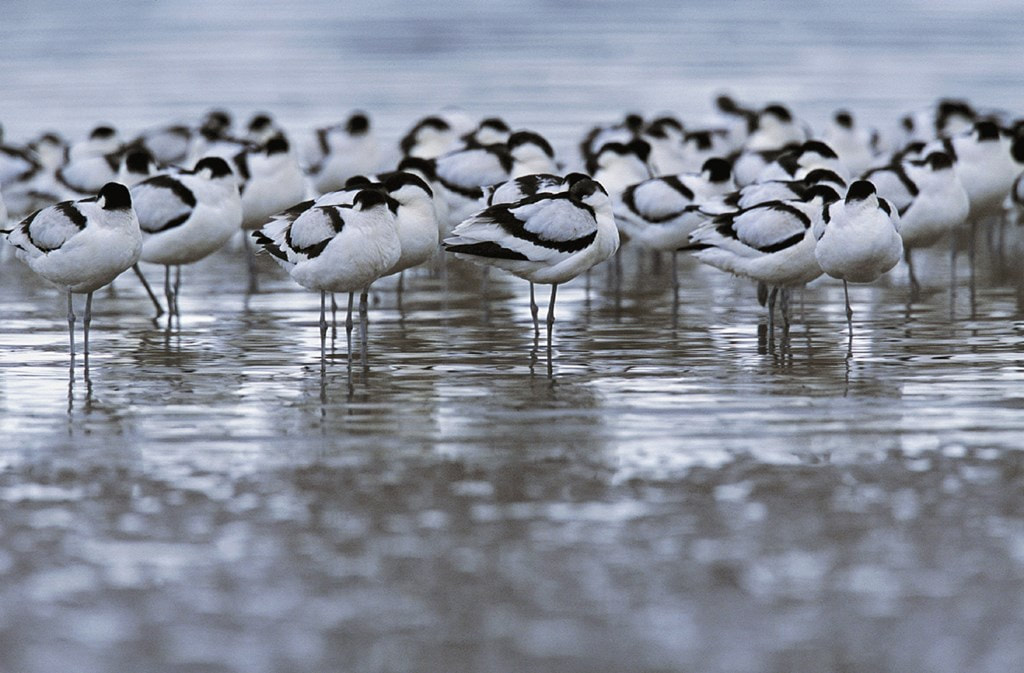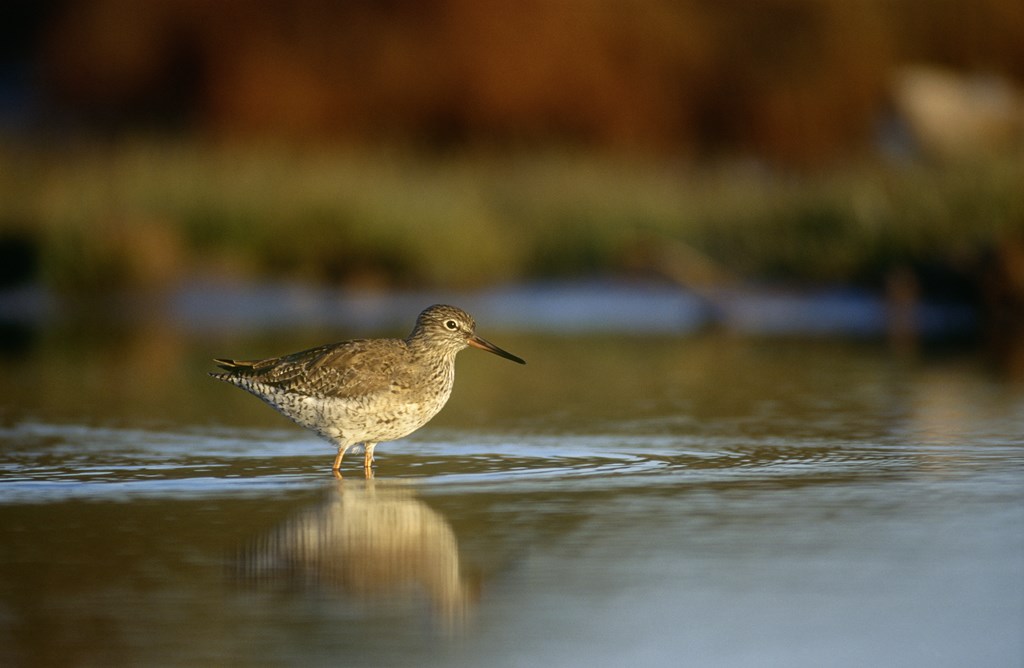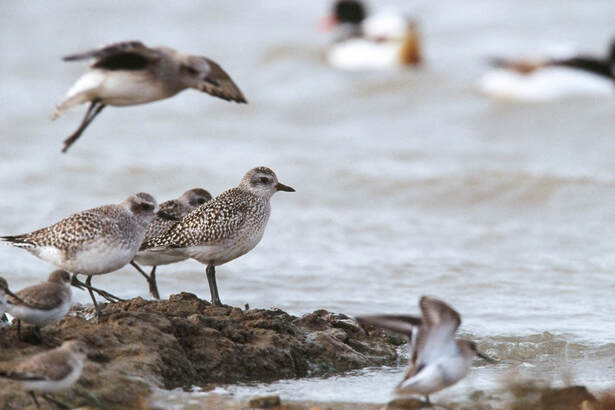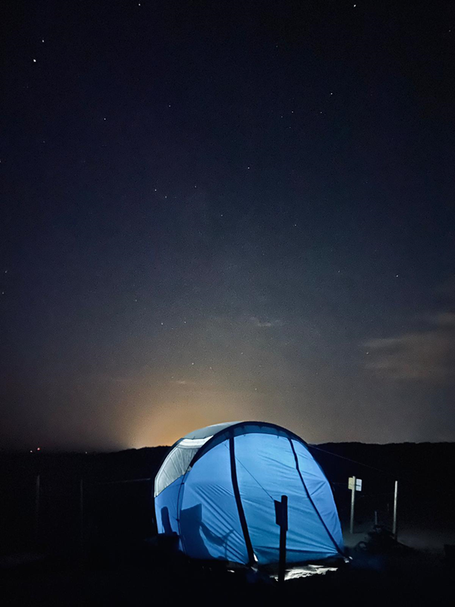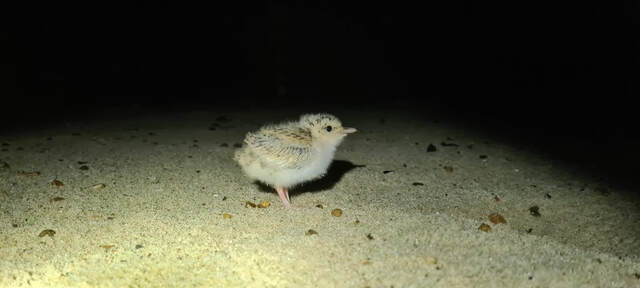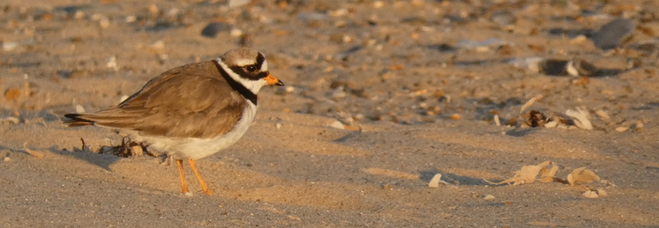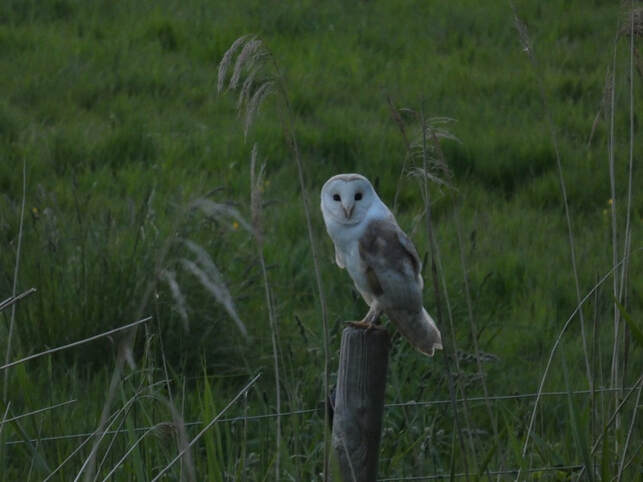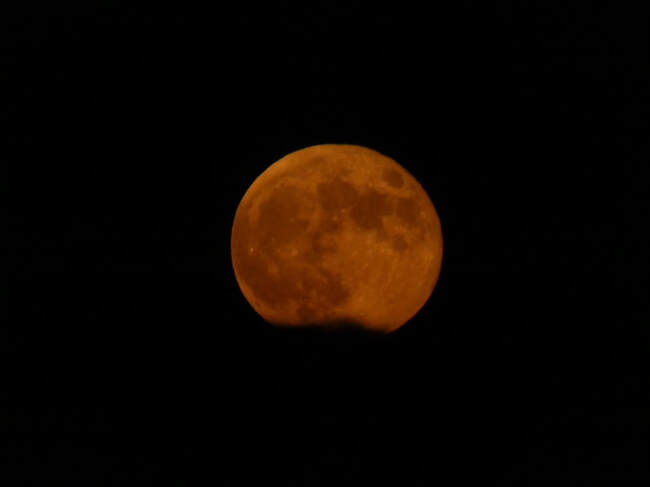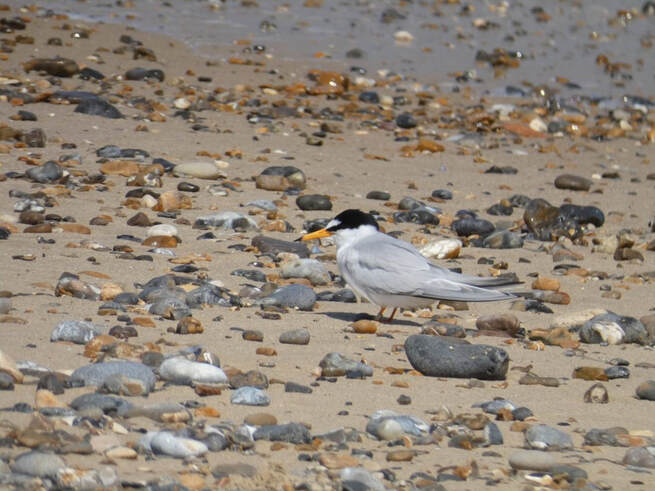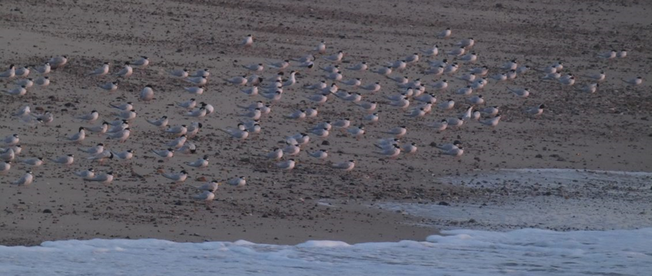|
Blog by Kieren Alexander, Site Manager for RSPB Old Hall Marshes Work is progressing nicely on the beneficial reuse project at Horsey island, with almost 25% of the material delivered by the Sospan Dau so far. The Sospan Dau is being skippered by a joint venture of Van Oord and Boskalis Westminster who have undertaken many such projects around the globe and are experts in this type of operation. They are able to access the disposal location at every high tide once they have found enough of the correct material from the Harwich Haven authority channel deepening source site, in this case sand and shingle. The material is then pumped ashore using a short length of floating pipe held in place by ropes and a small tugboat. This allows accurate disposal of the material and into the area it should be placed. You can track the boat here: Or here, MarineTraffic: Global Ship Tracking Intelligence | AIS Marine Traffic However, the best view is from the air and we were able to access Horsey last week and take this Drone footage. This shows the Sospan Dau approaching the island and discharging the material. At the moment the material resembles a large flat sand and shingle pancake. It will be shaped and sculpted by tide and wind over winter, moving landwards and westwards and in time building up the existing beach.
Although it doesn’t look like it now, the existing beach at Horsey is manmade, it was created in the 1990’s by the original Sospan Dau after a similar scheme where material was transported from a deepening project carried out by Harwich Haven Authority and the Environment Agency. It was after this that little terns colonised the beach and made this an important colony. However, the same forces that created the beach are also slowly causing it to be less suitable for nesting birds, it is slowly flattening out and lowering. This makes it much more vulnerable to storm events and high tides over the breeding season, which can lead to the complete loss of a breeding season. This work will make this scenario much less likely in the future in this location. In case you missed it, here is the link to first part of Horsey Island Recharge Project blog.
0 Comments
Blog by Aran Burton, RSPB Communications Officer While we come to terms with the effects of climate change on our way of life, coastal birds will also have to adapt, but they’re likely to struggle without intervention from us. It’s vital we mitigate the effects of climate change, such as the potentially catastrophic sea level rises that are predicted to severely affect the UK in the coming years. At RSPB Titchwell, we’re working to protect, and in some cases restore, the land being lost to coastal erosion and the damaging impact this is already having on wildlife. This is the aim of Life on the Edge, an EU-funded LIFE project, allowing us to provide new habitats, and protect existing ones, at seven nature reserves in England. It’s our duty to provide a future for coastal birds and their habitats, because human activity is the driving force behind climate change. The land at RSPB Titchwell Marsh nature reserve has been managed since the 1970s, but by 2009 flooding and coastal erosion began to bite. Efforts to protect and strengthen flood defence banks have been going on since 2011 and Life on the Edge, will help build on this. Titchwell Marsh attracts more than 80,000 visitors a year, who come to enjoy the birds nesting on the reserve, including bittern, avocet, bearded tit and marsh harrier. If these habitats are lost to coastal erosion, these populations of coastal birds will be lost as well – possibly forever. As the water levels in the reed bed change, this important habitat is becoming harder to manage. If the reed bed deteriorates, there are concerns it would eventually dry out and revert to willow scrub, which cannot support nesting bittern, bearded tit or marsh harrier. Freshwater marsh is also at risk from rising water levels, which could displace the avocets that nest here. Without intervention, climate change would fundamentally alter the landscape at Titchwell Marsh, and displace the hundreds of birds that nest in these special habitats. Thanks to Life on the Edge project work, this bleak future can be prevented. Work is already underway to reverse this decline and attract new species to the nature reserve, including the creation of 11 new islands in the marsh where birds can nest and roost. Flood defence banks have been raised and extended, and more than a kilometre of fencing to keep out predators has been installed. These improvements are essential for protecting ground nesting birds. In 2021 there have been 20 pairs of avocet and seven pairs of ringed plover, nine pairs of bearded tit and one booming bittern. This is positive, but we’d like to see more species flourishing in the marsh. While protecting breeding species is important, it’s also essential the needs of birds are met all year round. Titchwell provides vitally important habitats for wintering birds, including species that nest nearby in other parts of the Norfolk coast, such as redshank and oystercatcher. Titchwell also provides a winter home for species that nest in the Arctic, such as grey plover and knot. We don’t know what the future holds, both for us and our coastal birds, but by taking action now, we can ensure there is a future to be had. Guest blog by Will Bevan, RSPB Field Officer (Norfolk) I’m sat in a tent on the beach in East Norfolk, sitting comfortably but chilly in a fold out camping chair with some strong coffee, engrossed in a book. My watch says that 2 A.M. has just crept by, and the sounds of the night reach out to me in my reverie. Waves are crashing softly in the distance, and the tent flaps lazily in a gentle breeze. Sand hoppers - tiny crustaceans with springy tails - scale the walls, falling to the floor as they throw themselves at the solar powered light in a cyclical pilgrimage which will last until dawn. Wailing seals and the hoarse barking of a muntjac deer form an eerie chorus, backed by the low hum of distant ships. Then I hear it: "KYEEEK!" The sound cuts through the night and my ears prick up - a little tern alarm call. "KYEEK! KYEEK!" The noise is unmistakable, and although I patrol the colony regularly, the terns are a reliable early warning system. I grab my torch and thermal imaging camera, unzip the tent door, and head out into the dark. As my eyes adjust, I fumble to turn on the camera, and through the grayscale display I can see the colony clearly. Directing it to the source of the commotion I can make out a large blob glowing white with body heat, which from experience could be one of two things - a fox, or a muntjac deer. Whilst both will eat little tern eggs, the foxes will go for chicks and adults, and it’s the latter I'm concerned about at this stage of the season. The colony is surrounded by an electrified fence and poultry netting for this very reason, but nearly all the chicks have now hatched, and they wander freely outside the perimeter. I set off in the direction of the blob, which is casually trotting along the boundary of the colony. The terns are becoming increasingly agitated as more birds join the fray, diving and shrieking at the unknown assailant. I trudge across the dunes that back the colony at a swift pace, brushing past dew-dropped marram grass and thistly sea-holly, which has recently erupted into a riot of silvery-blue flowers. The terns have now noticed me, and some direct their outrage at my head. I apologise profusely and assure them that I'm not the problem - if they would bother to listen - and work my way closer to the din. When I'm near enough for it to reach, I turn on the torch and shine it in the direction of the blob. If it was a fox, I would catch the glint of its eyes for a split second before it bolted away at full speed - but it isn't. Instead, a muntjac deer squints blearily at me through the beam of light, undeterred by my presence. A disturbance maybe, but no real threat at this point. Not wanting it to jump over the fence, I walk cautiously towards the deer and it sets off at a light jog, before slowing down to its original pace. In this way I escort it gradually to the edge of the colony, and it meanders off over the dunes and into the night. The terns have settled down and I turn back towards the tent, a lonely lamp under a cavernous night sky, the stars glimmering like precious minerals encrusted on its surface. A waning moon is rising behind wispy black clouds, casting an ethereal glow across the beach, and beyond the vast North Sea lies a barely perceptible hint of dawn. * * * * * * Three months ago, and thousands of miles away, somewhere in West Africa, a primeval urge has awakened within the mind of a small seabird. This bird - a little tern (Sternula albifrons) - is about to migrate North for the breeding season, where longer days and productive seas make for more ideal breeding conditions than where it is presently. This is a journey it might have undertaken many times before, with the oldest recorded individual clocking in at an incredible 26 years of age. It will arrive at its destination around the end of April, and whilst some of its companions might travel to places like Denmark or the Netherlands, this particular bird is heading for the East Norfolk coast. Around this time another migration is also underway, as I pack up the flat in mid-Wales where I have spent the last 16 months in lockdown to travel to the same East Norfolk coastline, and begin my role as a Beach-Nesting Bird Field Officer with the RSPB. This little tern will be joined by hundreds more, and for a few months our lives will be entwined as I and others attempt to give them the best chance of a successful breeding season. Norfolk is a crucial stronghold for the little tern in the UK, with colonies of varying size dotted along its stunning coastline, much of which is designated as an Area of Outstanding Natural Beauty (AONB). Low breeding success has resulted in a long-term decline of the population, and so the birds need a helping hand to fight back against this worrying downward trend. Amongst them also nest ringed plovers (Charadrius hiaticula), dumpy little wading birds which are also struggling to breed. Like other beach-nesting birds around the world, they are threatened by loss of habitat, human disturbance, predation, and climate change, the latter causing more frequent stormy weather and higher sea levels which can wash out whole colonies from their nests, which are dug precariously into the sand and gravel. The presence of night wardens is a key strategy in little tern conservation, as colonies need protection from a host of ground predators including foxes, hedgehogs, and muntjac deer. Sadly, egg thieves are still an issue, and so a presence on the beach at night is also a good deterrent to people who would do the breeding terns harm. As a cold and blustery May slipped into June and brought with it some fairer weather, the first little tern eggs of the season were spotted. It was at this time I began my first night shifts, and on a balmy evening at the end of May, I cycled through the idyllic Norfolk countryside to the colony as the light began to fade. The journey to and from shifts was always a delight, with plenty of wildlife about at those unsociable hours. On many occasions I saw hares, barn owls, and deer, as well the odd group of spoonbills and cranes flying overhead! As June progressed, I gradually adjusted to working in the dark as the sensations of the night became familiar to me, such as the night calls of passing redshank and common sandpipers, and the otherworldly churring of nightjars drifting over the dunes. The night has a way of eroding the senses, and it was both a surreal and profound experience to be out there on the edge of things, feeling at once isolated but also deeply connected to the rhythms of the Earth and the cosmos. The night skies in August were some of the most awe inspiring, and on occasion I would lie on the beach and gaze upwards, letting the brilliance of countless stars wash over me. One moment in particular stands out, at the height of the Perseid meteor shower, when with a flash the whole night sky was illuminated as a flaming ball of rock plunged through the atmosphere. This is the closest I have ever seen a meteor, and I stood dumbfounded for a moment as I processed what I had just witnessed. The immensity of this stage contrasted greatly with the job I was there to do - protecting these tiny seabirds and their even smaller chicks from whatever awaited them in the darkness. I grew extremely fond of the little terns and was lucky enough to spend time with them during the day, as well as at night. They are the most endearing birds, graceful in flight and striking to watch, with a gentle chattering that soothes the soul. They are also extremely hard working, and once their chicks began to hatch, journeyed back and forth to sea almost constantly from dawn until dusk, needing large quantities of nutritious fish to fuel the rapid growth of their offspring. I came to see myself as their babysitter at night and spent much of my time outside of work worrying about their wellbeing. I needn’t have worried though, as this year as always saw an excellent team of dedicated volunteers and field officers, who care deeply about the terns as I do. It is thanks to them that we had a successful breeding season, and to the public who visited our beaches this year and helped us to give space for these birds to thrive. As I reflect on the season, I look back fondly at my night shifts, and would encourage anyone who can to get out and find somewhere away from the lights to go and appreciate the night sky. The Norfolk Coast and Broads Dark Skies Festival is running now, from the 25th September until the 10th October 2021, with the Norfolk coastline boasting some of the darkest skies in the country thanks to the lack of artificial light nearby. For more information on all the amazing events taking place, head to the Norfolk AONB website! * * * * * * It’s mid-August, and I climb back inside the tent after the incident with the muntjac deer, settle down into the chair, and get stuck into my book again. Outside the terns begin to stir, and as they awaken for the day their chattering begins, and I head outside to join them. The clouds are pink with the light of dawn and the steadily rising sun is peeling itself off the horizon with a growing intensity. A large flock of little terns is congregated along the shoreline, with just as many in the air commuting to and from the colony. In their slender yellow bills with tips dipped in black they clutch glistening fish freshly plucked from the sea. They descend to the peeps of their fluffy, speckled chicks, which dive out of cover for the catch dangled before them. I take a breath - in a couple of weeks, the terns and their fledglings will be gone, flying back to West Africa until next year’s breeding season begins. With any luck the young ones will survive to live long lives, and maybe we will be reunited again here on the shifting shores of East Norfolk. As I stand captivated by the scene unfolding before me, a heavy fog begins to roll in off the sea, and the visibility quickly deteriorates. The tent is engulfed, and I can barely see the colony fence or the tent, leaving me alone on the shoreline with the sound of the terns and the crash of the waves as the world around us disappears. |
Archives
April 2024
Categories
All
Photo credits: Oystercatcher by Katie Nethercoat (rspb-images.com)
LOTE Logo credits: Saskia Wischnewski |

